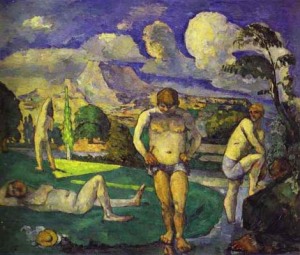Gabriel Josipovici, in his book Whatever Happened to Modernism, devotes a lot of attention to Cézanne as a modernist, an artist who realizes that he cannot supply ready-made meaning, a completed narrative.
The agony of Cézanne, the doubt he constantly feels about the value and even the point of what he is doing, stems from this, that he does not start with a given image, ready-made, but seeks instead to recreate each time the sense we have of the world coming to life as we look at and live in it. As Merleau-Ponty says:
We live in the minds of man-made objects, among tools, in houses, streets, cities, and most of the time we see them only through the human actions which put them to use. We become used to thinking that all of this exists necessarily and unshakably. Cézanne’s painting suspends these habits of thought and reveals the base of inhuman nature upon which man has installed himself. This is why Cézanne’s people are strange, as if viewed by a creature of another species. (96)
Musil is a modernist in just this way. We cannot help at times seeing his characters as members of a different species.
The General’s eyes began to itch, and to roll around gloomily, goggling at the translucent air around him. But Arnheim was not waiting to be asked for particulars; words flowed from his lips, from that pale pink slit between his clipped mustache and little pointed beard. (I,620)
At long last her fit began to wear off and her body quieted down. Her eyes brimming with tears, she sat up in the bed, her little breasts drooping slackly from a body not yet under the mind’s full control. Ulrich took a deep breath, again overcome with repugnance at the inhuman, merely physical aspects of the experience. (I,680)
Now for a few necessary words about a smile, specifically a man’s smile, and about a beard, created for the male act of smiling into one’s beard… (I,325)
With great and varied skills we create a delusion that enables us to coexist serenely with the most monstrous things, simply because we recognize these frozen grimaces of the universe as a table or a chair, a shout or an outstretched arm, a speed or a roast chicken. (I,574)
At night her head, heavy with unappeased cravings, sat on her shoulders like a coconut with its mat of monkeylike hair growing freakishly inside the shell, and she came close to bursting with helpless rage, like a drinker deprived of his bottle. (I,629)
Arnheim looked impassive where he sat, his lips slightly parted, like a bud opening. Diotima, a silent tower of radiant flesh, gazed at him across the moat between them. (I,650)

October 24, 2010 at 11:01 pm |
Do Cezanne’s card players share this strangeness with his bathers? Or is there just a search in both of them for the essence of human beings?
October 25, 2010 at 11:55 am |
I think the card players are strange. Their faces are emotionless (that’s considered good form in poker, though), even that of the young girl. The same is true of the one with two men and a wine bottle (and no wine glasses; very strange). I don’t think your questions are contradictory. Cezanne was exploring the essence of these players even while abstracting them into planes of color. The point is to see with fresh eyes.
October 25, 2010 at 1:34 pm |
Of course the art by definition is strange – it’s not a reality.
The card players just don’t seem to try to suspend our habits of thinking that all this man-made world exists necessarily and unshakably, and reveal the base of inhuman nature upon which man has installed himself.
I think they are more preoccupied with revealing the base of human nature. This is not contradictory to the previous task, and in the same way those questions before are not contradictory – of course you’re right.
October 25, 2010 at 3:03 pm |
I see your point. Cezanne is not strange in the same way Musil is.